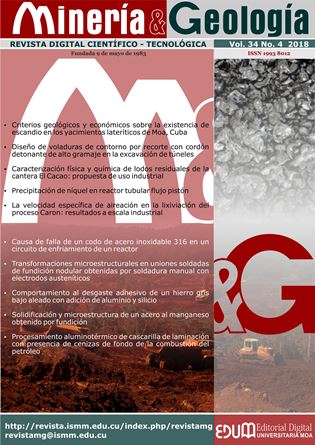Cause of failure of a 316 stainless steel pipe elbow in a cooling circuit of a reactor
Keywords:
break gear, stainless steel 316, corrosion, mechanical fatigueAbstract
This research deals with a study to determine the cause of cracking and later broke of an accessory made of stainless 316 steel in the cooling circuit of a reactor. Several characterization techniques were applied such as: optical emission spectrometry, sweep optical and electronic microscopy, including microanalysis with EDAX. It was concluded that the main cause of the failure are related to a mixing deterioration mechanism by intercrystalline corrosion sensitive, mechanic fatigue and stress corrosion cracking.Downloads
References
American Society of Metal. 2015: Metallography and Microstructure. Volume 9, ASM International.
Asghar, M. S. A.; Tariq, F. y Ali, A. 2010: Failure analysis of AISI-304 stainless steel styrene storage tank. Journal of failure analysis and prevention, 10(4): 303-311.
Cominox S. A. de C.V. 2012: Certificado de Calidad No 38642.
Conejero, O. y Mielgo, E. 2011: Fractura por corrosión de un componente de acero inoxidable AISI 316L debida a la presencia de fase sigma generalizada. Anales de Mecánica de la Fractura, 28(1).
Engelberg, D. L.; Marrow, T. J.; Babout, L. y Newman, R. C. 2014: Grain Boundary Engineering for Crack Bridging: Intergranular Corrosion and Stress Corrosion Crack Path Dependencies. In: 19th International Corrosion Conference. Beijing, China.
López-Cubas, C. A. 2013: Análisis de falla por corrosión bajo tensión en la tubería de un intercambiador de calor. Revista Politécnica, 9(17): 39-46. ISSN 1900-2351
Martínez, M. A.; Urdieres, J.; Botella, J.; Sánchez, R. y Parra, R. 2008: Influencia del tamaño del grano en las propiedades mecánicas de los aceros inoxidables austeníticos. Revista de metalurgia, 41(Extra): 64-68.
Mukhopadhyay, S. K.; Roy, H. y Roy, A. 2009: Development of hardness-based model for remaining life assessment of thermally loaded components. International Journal of Pressure Vessels and Piping, 86(4): 246–251.
Newman, R. C. 2001: Understanding the corrosion of stainless steel. Corrosion, 57(12): 1030-1041.
Romero-Hernández, J. L.; Ortiz-Valera, J. A. y Ortiz-Prado, A. 2013: Estudio de un caso de falla por corrosión en equipo de procesamiento de alimentos. Memorias del XVI Congreso Internacional Anual de la SOMIN. Monterrey, Nuevo León, México, 22-24 de sept.
Tedmon, C. S.; Vermilyea, D. A. y Rosolowsk, J. H. 2016: Intergranular Corrosion of Austenitic Stainless Steel. J. Electrochem. Soc., 2(118): 192-202.
Terán, G.; Tovar, C.; Portocarrero, J. y Sánchez, N. A. 2004: Estudio de la corrosión producida en aceros inoxidables 304 en procesos de soldadura. Dyna, 71(144): 61-66.
The American Society for Testing and Materials. 2015: Designation: E 407-15, Standard Practice for Microetching Metals and Alloys.
The American Society for Testing and Materials. 2016: Designation: A 733/A 733M-16, Standard Specification for Welded and Seamless Carbon Steel and Austenitic Stainless Steel Pipe Nipples.
The American Society for Testing and Materials. 2016: Designation: A 403/A 403M-16, Standard Specification for Wrought Austenitic Stainless Steel Piping Fittings.
The American Society for Testing and Materials. 2013: Designation: E 112-13, Standard Test Methods for Determining Average Grain Size.
The American Society for Testing and Materials. 2011: Designation: ASTM E3-11. Standard Guide for Preparation of Metallographic Specimens.
Vieira, D. H.; Pinto, D. F.; De Carvalho, J. A. N. y Bálsamo, P. S. S. 2015: Estudo do fenômeno de corrosão em juntas soldadas de aços inoxidáveis. In: Congresso Anual da ABM. Vol. 60: 555-565. Belo Horizonte.
Published
How to Cite
Issue
Section
Copyright (c) 2018 Eduardo M. Diaz-Cedre, Cesar A. Sánchez-Pérez, Amado Cruz-Crespo, Jesús I. Ruiz-Vela, Mauricio Tello-Rico, Nancy M. Pérez-Pino

This work is licensed under a Creative Commons Attribution-NonCommercial 4.0 International License.
- Authors retain copyright and guaranteeing the right magazine to be the first publication of the work as licensed under a Creative Commons Attribution-NonCommercial that allows others to share the work with an acknowledgment of the work's authorship and initial publication in this journal.
- Authors may establish separate supplemental agreements for the exclusive distribution version of the work published in the journal (eg, place it in an institutional repository or publish it in a book), with an acknowledgment of its initial publication in this journal.
- Authors are allowed and recommended to disseminate their work through the Internet (e.g., in institutional telematic archives or on their websites) before and during the submission process, which can produce interesting exchanges and increase citations of the published work. (See The effect of open access)










